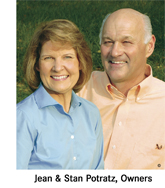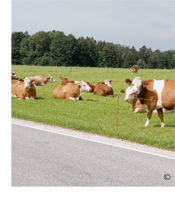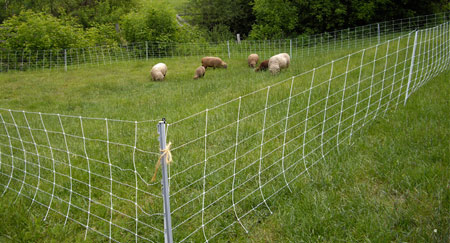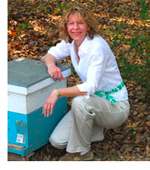Message from the Owner
Fencing Differences Between Europe and the USAEarlier this month, while wandering down farm lanes and poking into farm stores in Europe, I was again surprised by how different EU farmers are in their approach to fencing livestock as compared to ours in the USA. The livestock regions of continental Europe rely very heavily upon temporary electric fence—far more so than livestock owners in the US. And temporary electric fences in Europe are very often the only barrier alongside roads, lanes and public footpaths. Consider that often the fence (a single strand of tape or polywire on minimal posts powered by relatively weak battery energizers) is less than 3 feet from the active edge of a public right of way. So cars zip down lanes and/or the public walk so close to the cattle or horses inside the fence that each could reach out and touch the other. And dogs owned by the many folks walking on the vast array of public footpaths could readily go under the single hot-wire and frighten livestock. Permanent physical barrier fences exist, but much less so than in England and the USA. Now, most in the Midwest would not dare fence our livestock this way. Instead, the majority build strong physical barriers (wire for cows and sheep; wood or plastic for horses) along property boundaries-and these physical fences are set up far away from the active edges of public right-of-ways. Electric fences here are used to subdivide pastures, to provide lower cost perimeter boundaries within a farm or ranch, and to enhance a physical barrier fence. The energizer used here is often a powerful plug-in energizer from which power is fed to an array of fences via cables, feeder wires and switches. And we don't have the vast array of public footpaths.
Why do the two farm cultures use electric fence so differently?
How do the actual fence components compare between the two cultures? Forty years ago, when I farmed in England, the quality of electric fence components (energizers, wire, posts, etc.) in the USA lagged behind that of Europe. This is not longer true. A percentage of USA fence components have improved and EU fence components have not. So now an intermingled array of fencing—some very good, some good, and some dubious to the point of being useless/expensive/dangerous—can be found on the farms and in the farmstores of both areas. Recognizing this, we use Premier's farms to allow us to "up close and personal" which products work and which disappoint. And we rely on direct feedback from users across the USA to add to the understanding. Best wishes to you all until next time, Stan Potratz, Owner Special Price from Premier!Autumn Fence Specials
An end-of-summer opportunity to buy our elite netting, EnduraSoft and EquiLine at the lowest prices. HoriSmart units, which we introduced this year, feature unique, patented electronics that reduces possibly risk to humans and animals. They've been tested and proven in Europe—but we want more of these operating "in the field" in the USA so we reduced prices. 10% off Netting and Conductors(Use code: WNEWSF)Netting
Conductors
20% off Horismart Energizers(Use code: WNEWSG)110v AC Plug-In Energizers
Battery Energizer
Note: To receive discounts type the above promo code(s) in the Promo Code Box at checkout. Code box will be on the last screen of the checkout (Confirm & Submit page). If your order contains items from both promo codes-use WNEWSF in the promo box and the energizer code (WNEWSG) in the comments box at the bottom of the Confirm & Submit page and we will adjust it in-house. Offer expires on October 9, 2009This offer cannot be combined with any other claim codes or offers (However, free shipping does apply for qualified orders, click here for details.) Photo Contest Winner!
First winner of our Photo Contest is Gina Euhardy of Mount Horeb, Wisconsin. She writes: "We just started out with a small flock of babydoll sheep (4 adult ewes and 2 ewe lambs) and have them grazing a pretty steep section of our lawn. With the ElectroNet, we make a paddock in the yard with access to the barnyard for shade, shelter, and water. This paddock is set up using one 164 ft roll of ElectroNet fence, powered with a Kube energizer and a 12v battery. "What I love about the ElectroNet is that it is so easy to move; we've had to do it every few days to keep the grass fresh and have had no problems doing it that often. I can certainly do it by myself, and it adapts well to our hill and irregularly shaped lawn. It keeps our house dogs out and keeps sheep in :) "Being new to sheep altogether, it has been wonderful to learn so much from your website and to work with such great products. The web video tutorial on setting up electric net fencing made it so simple!" Congratulations Gina! Premier TipNetting to Protect Against BearsNetting makes an excellent barrier for bears. Properly electrified, it can be used to protect crops, beehives, picnic areas and campsites. Netting is both quick and easy to set up and remove. To use, surround the desired area, set the posts by hand, place any additional support posts that might be necessary, and attach an energizer. Then test to make sure everything is working properly. This type of fence has been protecting investments from bears for years. Premier VIP
What Kind of Queen?by Jennifer Berry Honey bees were first introduced into this country in the early 1600s by settlers from Europe. The race of bees that traveled by boat to the Americas was Apis mellifera mellifera, commonly known as the Dark, German, or Black bee. The German bee was predominant for decades but later lost ground to the imported Italian honey bee because of certain undesirable characteristics. Beekeepers were annoyed with the temperament of the German bee. It was defensive, nervous on the comb and would boil out of the colony when disturbed. It was also very susceptible to European Foul Brood, which swept the country in the early 1900s. Colony losses were severe enough to spark a move towards the Italian honey bee. Today in the U.S., Apis m. mellifera is very uncommon and probably doesn't even exist in its pure form. The Italian honey bee, Apis mellifera ligustica, is still the dominant player in the bee industry today. When you order package bees and queens from commercial sources, the bee you more than likely will receive is the Italian honey bee: aka the "three-banded Italian." These bees became popular for numerous reasons. First, they tend to be a semi gentle bee, not overly defensive or nervous on the comb. Second, Italians can handle most of the climatic variety that the Americas offer. Third, they don't use a tremendous amount of propolis; and finally, swarming is not on the top of their list. The main complaint surrounding the Italian honey bee is their propensity to produce a ton of bees. This is fantastic while plants are bearing nectar and pollen but not so much when the blooms have disappeared. Unfortunately, the trend to produce wall to wall progeny continues into the Summer and Fall. This equates to more mouths to feed, which in turn means dwindling honey stores, which translates to either less honey removed by the beekeeper or more trips to the apiary to feed sugar syrup. In the past the Italians were the reigning monarch in the U.S. but in recent decades they've been challenged. The Carniolans along with the Russians are gaining in popularity. Carniolans, Apis mellifera carnica, are a dark, grey bee that originated in Slovenia. The Carniolan gained popularity because of its gentle disposition and resistance to brood diseases. The other advantage they have over the Italian is their ability to "flow with the flow." In other words, they build up quickly in the late Winter in time for the Spring flow, then shut down brood production when nectar and pollen become scarce. The Carniolans overwinter in smaller clusters and hence honey stores are conserved. The only disadvantage is their tendency to swarm more readily when the brood nest becomes overcrowded. Sue Cobey's breeding program developed the "New World Carniolan." Over decades queens in her program have been evaluated and selected for their ability to resist pests and diseases while still exhibiting important traits like overwintering ability, gentleness, increased brood and honey production. Another western honey bee, the Caucasian, Apis mellifera caucasica, originates from the high valleys of the Central Caucasus. This is a geopolitical region located between Europe, Asia and the Middle East. The Caucasian is a race of gentle, dark bees that aren't bothered when beekeepers open their hive. They are slow to expand in the Spring but eventually can reach fairly large populations by mid Summer. They do have a few negative attributes, which is probably what has kept them from gaining too much ground. Probably the most annoying to beekeepers is their tendency to collect and use propolis. Over the years beekeepers have selected against this trait due to the difficulty it added while working colonies; sticky hive tools, fingers, or gloves in warm weather while in cooler temperatures frames, lids, and inner covers cemented together. Caucasians are also inclined to drift, and robbing behavior can be bothersome. You won't find them very often anymore for these reasons. The newest arrivals on the scene are the Russian bees, which have been growing in popularity over the years. They are a mixed hybrid of Apis mellifera and come from Primorsky region of far-eastern Russia. In the mid-1800s, settlers brought European bees, perhaps several races in all, to this area, which was already inhabited by the native Indian honey bee, Apis cerana, the original host of Varroa destructor. It is believed that these initial populations of European honey bees became infested with Varroa and over time developed resistance in order to survive. Hence Russian bees have been exposed to Varroa mites longer than other races of A. mellifera. In 1997 Dr. Thomas Rinderer, USDA Bee Lab Researcher, imported these bees into North America. In 2007 the Russian Honey bee Breeders Association was formed. The purpose of the association "is to maintain and improve the various lines of Russian honey bees through propagation and selective breeding." The Russian bee is a dark bee that overwinters in small clusters and can withstand harsh Winter conditions. They are good honey producers but shut down brood production earlier than Italians, which is good for conserving honey stores. Russians are inclined to build numerous queen cells during the brood season and can swarm more readily than some other bees. Finally, I'd like to mention the Minnesota Hygienic, which isn't a race of bees but rather a line of queens selected for a particular trait. Developed by Dr. Marla Spivak at the University of Minnesota, hygienic bees will detect, uncap, and remove infected or infested brood from the combs. Bees with this behavior reduce the incidence of diseases like American foulbrood and limit reproduction and therefore population growth of mites and small hive beetles. These queens are commercially available. While thumbing through the bee journals you will notice numerous ads selling queens. To a new beekeeper this can be a bit overwhelming. How do you know which queen is best for you, or your location? This is when a local mentor comes in handy. Talk with them or other members in your club to see which queens they've been purchasing over the years. You will quickly find out that beekeepers can be opinionated, especially when it comes to a race or line of bees they've been keeping. Actually, if you stay in beekeeping long enough, you will be also. You may receive conflicting stories about which queens to purchase, and hence your path becomes even more unclear. So experiment. Purchase several different queens from different breeders and make your own decision. Another way to narrow the selection process is to find a queen breeder that fits your particular beekeeping philosophy. After you muddle through and figure out which queen you want to purchase, you need to order her sooner than later. By now it's March. Most early queens are already sold but they should be available later in the year. If you prefer to re-queen in the Fall you still have plenty of time. If you have never received queens in the mail let me give you a few pointers. Depending on whom you purchase your queen from will determine how she arrives. If you are ordering a few queens they usually arrive in a sturdy cardboard, postal envelope or box. Holes are cut for ventilation and the queens will be in individual cages (wooden or plastic) inside. If you are purchasing a large number of queens, they're usually shipped in a battery box—a cardboard box with wired mesh windows. Inside the queens are securely housed in individual cages. The main difference between the two methods is the location of the attendants. In the envelope, the attendants are placed inside the cage with the queen. In the battery box, they're shook directly into the box and then sealed. Hence, there are live, free-flying bees inside the box but outside the queen cages. It's usually not a good idea to open the box inside unless you like buzzing bees at windows and lights. The battery box is supplied with queen candy, which the attendants consume and then feed to the queens. Cages with attendants have the queen candy inside at one end. If you are unable to install your queen when she arrives, take the cage out of the envelope and place a few drops of water directly on the screen towards the end where the candy is located. Not too much water, you don't want to drown them. This will help the nurse bees consume the candy and feed it to the queen. Then place the queen back in the envelope and keep it out of direct sunlight and away from any heat source. If your queens arrive in a battery box, lightly squirt water through the wired opening to hydrate the bees; again not too much. It is also a good idea to place your queen(s) someplace where the cat, dog, ferret, gerbil, rabbit, or snake will not have access. I've heard numerous stories about the horrible demise of queens due to a quick swipe of the paw or snap of a jaw. Before installing a queen it is a good idea to remove the attendants. Several years ago Wyatt Magnum conducted research that showed acceptance rates increased when queens were introduced without attendants. Removing these attendants can be tricky if you're not used to handling bees/queens. If your queen is in a wooden cage, both ends will have a cork plug securely in place. Remove the plug on the end without the queen candy and let the attendants out. Preferably you want to have the cage in some sort of clear bag, queen muff, or veil covering because the queen may shoot out of the hole and take off flying. This can be disturbing when you watch the newly purchased queen fly off into the wild blue yonder. If she escapes the cage, just carefully grab her by the thorax and gently place her head into the hole of the cage. She will be grateful to return to the cage if it means being released from the Giant Fingers. Plastic cages have a cap but usually the candy is in that part of the cage. There is a second plastic cap that is attached to the cage. Gently remove it and allow the bees to exit. If you are brand-spanking-new at beekeeping you may want to just leave the attendants in the cage and install her. Once you feel confident picking up queens, then you can attempt this. If the queens are in a battery box, you don't have to worry about removing attendants. Just open the box next to the hive and insert the queen. Here is how I introduce a queen. Open the colony, find the old queen and remove her. Open one end of the queen cage and remove the attendants, then replace the cork or plastic cap. I take a small amount of honey with my hive tool and touch the corner of the screen. The queen will usually immediately start to feed on the honey. When inserting the queen cage, I prefer to put the queen-candy side down. This way there is no chance of the queen-candy melting and seeping down, entombing the queen. Since there aren't any attendants, no dead bodies could possibly block the candy. After several days I personally release the queen from her cage. I want to see the queen emerge from her cage, walk out onto the comb and be greeted, lovingly, by her new court. If bees are balling the cage (layers of worker bees curled up around the cage, biting and trying to sting the new queen), I leave her for another day or two. Take care with this newest member. Remember, without her there's no colony. I'm going to change the subject for just a minute, but I promise there is a point. Recently it seems our souring economy has been on everyone's mind. Turn on the radio, TV or computer and you're bombarded with doom and gloom—stock market down again, raising unemployment, foreclosures, failed bailouts, company closures, corporate thieves and increasing crime rates. Driving around Athens, Georgia I see the direct results of our failing economy. Folks standing on the roadside with large orange signs that read, "Going out of business, 60 to 80% off, everything must go." It's the topic of conversation at dinner parties and lunch socials. Friends in the restaurant business are wondering how they can hold on for another month. Houses still on the market for over a year have new "for sale" signs reading "Price Lowered." With all this concern about the economy, one would think that the interest in beekeeping would also take a downturn. It doesn't seem to be the trend, so far. Maybe it's due to all the headlines about CCD or the desire to save money by making one's own honey. Who knows? But we, as consumers, are still wary of carelessly letting go of our hard-earned money. Purchasing beekeeping equipment, bees and queens may still be on our list but we want more reassurance that the product is good. Where am I going, you ask? Last year I was invited to speak at the Western Reserve Beekeepers Association, in Medina, Ohio. One of the highlights of my trip was a tour of the A.I. Root Company; you know, the place they make all of those fabulous candles. I saw first hand how votives, pillars, and tapers were made, colored and scented. It was a fascinating tour. But more interesting was the building that A.I. Root built back in 1869. It is still standing and houses this amazing company. While on the tour, Kim Flottum, tour master and editor of this magazine, handed me the fourth issue of Gleanings magazine dated 1876. I sat down and gently began to thumb through it. One thing that caught my eye was the advertisements for queens and bees. A few of those are in that yellow chart. Just for fun, I converted the 1876 price to today's (actually, 2007) to see if the industry has kept up with inflation, which is where those numbers come from on the chart. Now granted, I'm oversimplifying a bit, but it seems to me that we're getting queens and bees today at a steal. Maybe our beekeeping dollar isn't hurting so bad. See ya! Jennifer Berry is the Research Coordinator at the University of Georgia Bee Lab Premier Employee Spotlight
Mike CordermanMike Corderman is this month's featured employee. He lives in Crawfordsville, Iowa, and has been the shepherd at Premier for 6 months. Prior to coming to Premier, he lived in northwest Iowa and raised 100 head of 1/4 Romanov, 1/4 East Friesian and 1/2 Polypay ewes, which he purchased from the McNay Research Farm. Mike and his wife, Susan, have been married since 1980 and have 5 children: Tracy, Shanna, Clint, Chance and Christa. At Premier, Mike says he likes "working with the sheep and having what I need when I need it." He adds, "The Premier people are always so eager to help and to assist at whatever might need to be done." His interests are working with livestock, vegetable gardening and being connected with the land. He also favors welding projects, likes pheasant hunting and has plans to restore his 1964 Harley Davidson and maybe someday to learn how to fly. Mike's favorite statement: "Old enough to know better, too young to resist." RecipeBroccoli SaladIngredients: 1 cup mayonnaise To make dressing, mix together mayonnaise, vinegar and sugar. Combine remaining ingredients and toss with dressing. Chill at least 4 hours before serving. From Cheyenne Miller, Premier Employee |







